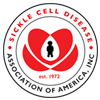Trusted Resources: Evidence & Education
Scientific literature and patient education texts
Age is a Predictor of a Small Decrease in Lung Function in Children With Sickle Cell Anemia
source: American Journal of Hematology
year: 2018
authors: Willen SM, Cohen R, Rodeghier M, Kirkham F, Redline SS, Rosen C, Kirkby J, DeBaun MR
summary/abstract:The longitudinal pattern of lung function in children with sickle cell anemia (SCA) has shown a decrease in FEV1% predicted, a risk factor for death in adults with SCA, but predictors for this decline are poorly characterized. In a prospective longitudinal multi-center cohort of children with SCA, we tested the hypotheses that: (1) FEV1 % predicted declines over time; and (2) SCA-specific characteristics and therapy predict this decline.
At three clinical centers, children with SCA (HbSS or HbSβ0 thalassemia), unselected for respiratory disease, were enrolled in the Sleep and Asthma Cohort (SAC) study. Study-certified pulmonary function technicians performed spirometry and lung volumes. Each assessment was reviewed centrally. Predicted values were determined for TLC, FEV1 , FVC, and FEV1 /FVC ratio. A total of 197 participants, mean age 11.0 years at first testing (range 4-19.3 years), had a minimum of three spirometry measurements, over an average of 4.4 years (range 1.1-6.5 years) from baseline to endpoint. In a multivariable model, FEV1 % predicted declines by 0.3% for every additional year of age (95% CI -0.56 to -0.05, P = .020).
Sex, asthma history, hemoglobin, reticulocyte count, white blood cell count, incidence rate of severe acute pain and acute chest syndrome episodes, and hydroxyurea therapy were not associated with a decline in FEV1% predicted. In a large, rigorously evaluated, prospective cohort of an unselected group of children with SCA, FEV1% predicted declines minimally over an average of 4 years, and none of the examined disease features predict the decline.
organization: Vanderbilt University Medical Center, USA; Boston University School of Medicine, USA; Rodeghier Consultants, USA; Institute of Child Health, UK; Brigham and Women's Hospital, USA; University Hospitals-Cleveland Medical Center, USADOI: 10.1002/ajh.25003
read more full text
Related Content
-
Transfusion-Induced iron overloadThe human body has no active mechanism f...
-
Sickle Cell Disease – The ‘Invisible’ Illnesshttps://www.youtube.com/watch?v=OXFWezTx...
-
Adult Sickle Cell Clinic at UAMSThe University of Arkansas for Medical S...
-
Sickle cell warrior documentaryhttps://www.youtube.com/watch?v=ZxC4vtN2...
-
Blood exchange transfusion safety for priapism in sickle cell disease: a single institution reviewBackground: Males with sickle cell disea...
-
Julie Kanter, MDDr. Julie Kanter is the Associate Profes...
-
The Sickle Cell Transplant Advocacy & Research Alliance (STAR)The Sickle Cell Transplant Advocacy &...
To improve your experience on this site, we use cookies. This includes cookies essential for the basic functioning of our website, cookies for analytics purposes, and cookies enabling us to personalize site content. By clicking on 'Accept' or any content on this site, you agree that cookies can be placed. You may adjust your browser's cookie settings to suit your preferences. More Information
The cookie settings on this website are set to "allow cookies" to give you the best browsing experience possible. If you continue to use this website without changing your cookie settings or you click "Accept" below then you are consenting to this.




 +myBinder
+myBinder
